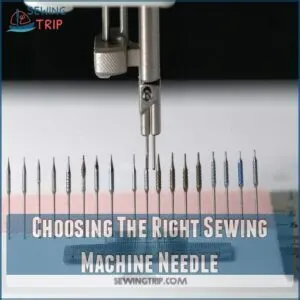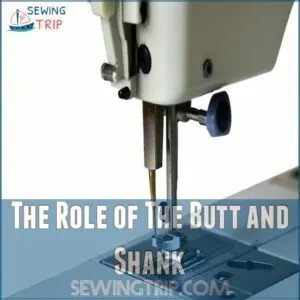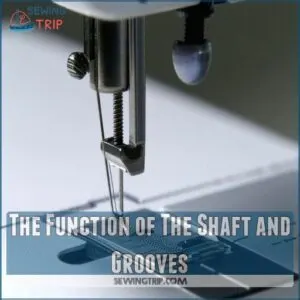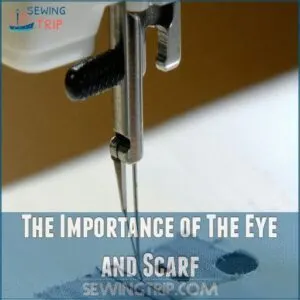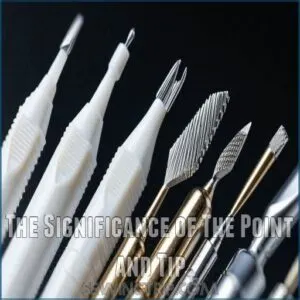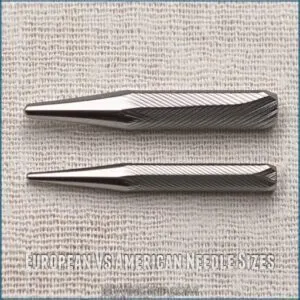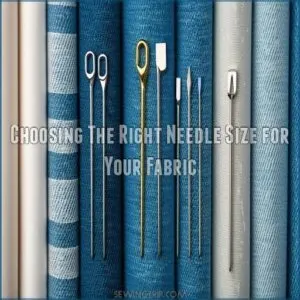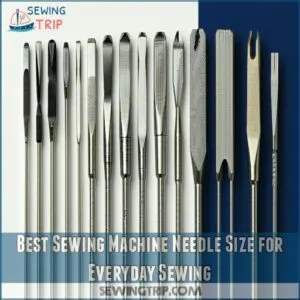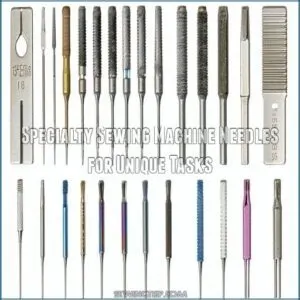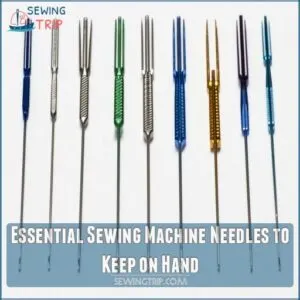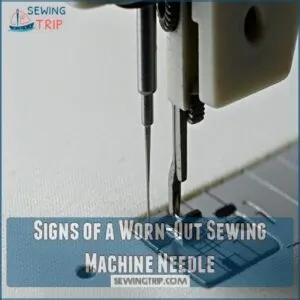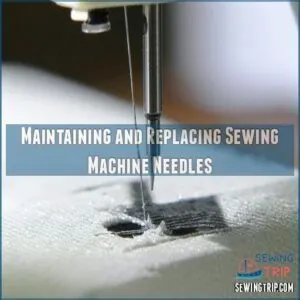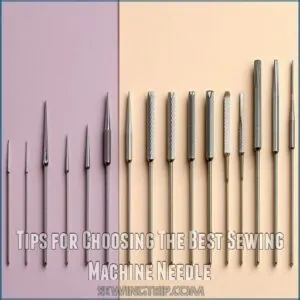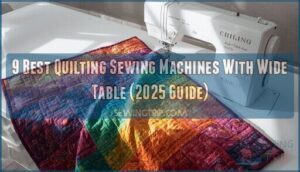This site is supported by our readers. We may earn a commission, at no cost to you, if you purchase through links.
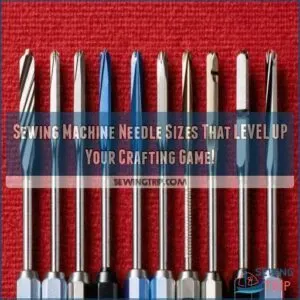 Want to nail your sewing projects? Choosing the best sewing machine needle size is your secret weapon!
Want to nail your sewing projects? Choosing the best sewing machine needle size is your secret weapon!
For lightweight fabrics like silk or chiffon, grab a tiny 8/60 or 9/65 needle.
Medium-weight cotton and polyester? A trusty 90/14 is your go-to.
Tackling denim or canvas? Beef up with a 100/16 or 110/18 needle.
Heavyweight upholstery demands those robust 16/100 or 18/110 needles.
Pro tip: always match your needle to your fabric’s thickness like a matchmaker.
Remember, the right needle can transform a good project into a show-stopping masterpiece – your stitches will thank you later.
Table Of Contents
- Key Takeaways
- Choosing The Right Sewing Machine Needle
- Sewing Machine Needle Parts Explained
- Sewing Machine Needle Sizes and Their Meanings
- Types of Sewing Machine Needles for Specific Fabrics
- Best Sewing Machine Needle Size for Everyday Sewing
- Specialty Sewing Machine Needles for Unique Tasks
- Essential Sewing Machine Needles to Keep on Hand
- Signs of a Worn-Out Sewing Machine Needle
- Maintaining and Replacing Sewing Machine Needles
- Tips for Choosing The Best Sewing Machine Needle
- Frequently Asked Questions (FAQs)
- Conclusion
Key Takeaways
- You’ll want to match your needle size to your fabric’s thickness, using smaller needles (8/60 or 9/65) for lightweight fabrics and larger needles (16/100 or 18/110) for heavyweight materials like denim or canvas.
- Don’t stick to just one needle type; build a versatile collection including universal, ballpoint, and sharp needles to tackle different fabric types and sewing projects effectively.
- You’ll need to replace your sewing machine needle every 6–8 hours of use or immediately after hitting a pin, to prevent fabric damage, skipped stitches, and poor stitch quality.
- A 90/14 universal needle is your go-to for most medium-weight fabrics, offering versatility and reliable performance across cotton, polyester blends, and lightweight denim.
Choosing The Right Sewing Machine Needle
If you’ve ever wondered why your stitches aren’t turning out quite right, the secret might be hiding in your sewing machine needle.
Choosing the perfect needle is like selecting the right tool for a job.
It can make all the difference between a frustrating crafting session and a professional-looking project.
Considering Fabric Weight and Thread Type
Ever wondered why your stitches look wonky?
It’s all about matching your needle to your fabric weight and thread type.
Understanding the needle size chart is vital for success.
Think of your needle as a precision tool: thicker threads need bigger needles, while delicate fabrics demand finer points.
Get this pairing right, and you’ll nail perfect stitches every time, avoiding fabric damage and frustrating sewing mishaps.
Factors Affecting Needle Selection
Selecting the perfect sewing machine needle isn’t rocket science, but it can make or break your crafting project.
Your needle choice depends on multiple essential factors that’ll determine your sewing success.
- Fabric type dictates your needle’s personality
- Thread weight whispers its own requirements
- Project complexity demands specific needle characteristics
For instance, sewing fleece requires a sharp, high-quality needle suitable for heavy fabrics, such as a universal or stretch needle.
Master these factors, and you’ll transform ordinary sewing into extraordinary craftsmanship.
Sewing Machine Needle Parts Explained
Ever wondered what makes your sewing machine needle tick?
Understanding the anatomy of your needle isn’t just for pros—it’s your secret weapon to crafting perfection.
Helping you choose the right needle for every fabric and stitch.
The Role of The Butt and Shank
Now that you’ve got your fabric sorted, let’s zoom in on the needle’s powerhouse: its butt and shank.
Think these as the needle’s backbone—providing stability and grip in your machine.
The butt connects to your machine, while the shank’s unique design provides rock-solid positioning.
Different sewing machine needle sizes mean subtle shank variations, so matching the right needle gives you precision control.
The Function of The Shaft and Grooves
Peering into the heart of sewing machine needles reveals the vital shaft and groove system.
These precision-engineered elements play a key role in your crafting success:
- Guiding thread smoothly through fabric
- Reducing friction during stitching
- Stabilizing needle movement
- Preventing thread breakage
The shaft’s carefully designed groove guarantees your stitches glide effortlessly, transforming potential frustration into sewing mastery.
The Importance of The Eye and Scarf
After exploring the shaft’s role, let’s zero in on the eye and scarf – your needle’s secret weapons for smooth sewing.
The eye’s size isn’t just a hole; it’s a critical gateway for thread flow, determining how seamlessly your fabric comes together.
The scarf’s unique design prevents needle damage, ensuring your stitches glide like butter across different fabric types.
The Significance of The Point and Tip
Your needle’s point and tip are the unsung heroes of precision stitching, determining how smoothly your fabric gets pierced.
Different point types dramatically impact your sewing success:
- Sharp points slice through tightly woven fabrics like a hot knife
- Ballpoint tips gently separate knit fabric threads without causing runs
- Leather points punch through tough materials with surgical accuracy
- Embroidery points minimize fabric stress during intricate designs
Sewing Machine Needle Sizes and Their Meanings
You’ll discover the secret to perfect stitches once you understand sewing machine needle sizes and their hidden meanings.
Don’t let those mysterious numbers intimidate you—they’re your roadmap to selecting the right needle.
That right needle will make your fabric sing and your projects shine.
European Vs American Needle Sizes
Ever wondered why your sewing needle sizes seem like a secret code?
The realm of sewing machine needles splits into two sizing systems that’ll make your head spin.
Here’s a breakdown to help you crack the needle size mystery: For a better understanding of the needle sizes, refer to a detailed needle size chart to facilitate correct usage.
| System | Range | Description |
|---|---|---|
| American | 8-20 | Lower number = thinner needle |
| European | 60-120 | Number = diameter in 100ths mm |
| Conversion | Paired | Easy cross-reference |
Choosing The Right Needle Size for Your Fabric
Now that you’ve got the lowdown on European and American needle sizes, let’s match those numbers to your fabric’s personality.
Picking the right needle size isn’t rocket science—it’s about understanding your material’s vibe.
When selecting a needle size, also consider the fabric grainlines to facilitate a smooth sewing process.
Here’s a quick cheat sheet for fabric matchmaking:
- Silk and chiffon? Stick to 8/60 or 9/65
- Cotton and lightweight synthetics? 11/75 is your friend
- Quilting fabrics love 14/90
- Denim demands 16/100
- Heavy upholstery fabrics? Grab an 18/100
Types of Sewing Machine Needles for Specific Fabrics
Not all sewing machine needles are created equal, and picking the right one can make or break your crafting project.
Whether you’re working with delicate silk, stretchy jersey, or tough denim, understanding the specific needle types for different fabrics will transform your sewing from amateur to pro-level in no time.
Universal Needles for General Sewing
After mastering needle sizes, sewists find universal needles to be their secret weapon.
These jack-of-all-trades needles tackle medium-weight woven fabrics like cotton and polyester blends with surprising versatility.
Ranging from size 75/11 to 90/14, universal needles work magic across multiple fabric types, making them a must-have in any sewing kit for crafters who want flexibility without switching needles constantly.
Ballpoint Needles for Knit Fabrics
Universal needles might work okay, but knit fabrics demand special attention.
Ballpoint needles are your secret weapon for smooth stitching on stretchy materials.
Their rounded tips gently separate knit fabric threads instead of piercing them, preventing unsightly runs and skipped stitches.
Choose a 75/11 or 90/14 ballpoint needle to keep your jerseys, leggings, and stretchy tops looking professional.
Sharp Needles for Straight Lines and Delicate Fabrics
If ballpoint needles smoothed out your knit fabric challenges, sharp needles are your secret weapon for precision stitching.
These razor-focused friends slice through high-density woven fabrics like a hot knife through butter.
Your stitch quality skyrockets with needle sharpness perfectly matched to delicate materials, minimizing fabric breakage and ensuring professional-looking results every single time.
Specialty Needles for Leather, Denim, and Stretch Fabrics
Some crafting challenges demand superhero-level needle precision when tackling tough fabrics like leather, denim, and stretch materials. Your sewing machine deserves specialized needles that can handle these fabric rebels.
To find the perfect needle for your leather projects, consider the best needle size for leather, which can vary depending on the type and thickness of the material.
- Leather needles slice through thick materials with laser-sharp accuracy
- Denim needles pack extra strength for heavy-duty fabric conquests
- Stretch needles flex and glide seamlessly across knit fabrics without leaving a trace
Best Sewing Machine Needle Size for Everyday Sewing
When you’re just starting out or working on everyday sewing projects, choosing the right needle size can make or break your crafting experience.
A universal 90/14 needle is your go-to secret weapon for most medium-weight fabrics.
Giving you professional-looking results without the frustration of broken threads or skipped stitches.
For Lightweight and Medium-Weight Fabrics
When picking needles for lightweight and medium-weight fabrics like cotton voile or quilting material, reach for sizes 11/75 or 14/90.
These versatile needle sizes dance perfectly with delicate threads, ensuring smooth stitches without punching holes bigger than necessary.
Your fabric won’t know what hit it – crisp, clean lines await with the right needle choice.
For Heavyweight and Very Heavyweight Fabrics
Ready to tackle those heavyweight fabrics like a pro? After mastering lighter materials, you’ll want a beefier needle for thick projects. Here’s your heavyweight fabric needle survival guide:
- Grab a 16/100 or 18/110 size
- Choose denim or leather needles for extra strength
- Look for thick, sharp points
- Select needles with reinforced shafts
- Opt for heavy-duty brands like Schmetz
For heavy canvas, consider matching thread to needle size like with durable threads for best results.
These powerhouse needles slice through canvas, denim, and upholstery like a hot knife through butter.
Specialty Sewing Machine Needles for Unique Tasks
Ready to take your sewing projects from basic to brilliant with specialty needles that can handle any fabric challenge?
Whether you’re working with delicate metallic threads for embroidery or stretchy knits that demand precision, the right needle can transform your crafting experience and elevate your skills.
Metallic Needles for Embroidery and Decorative Stitches
After mastering basic fabric weights, you’ll want to sparkle with metallic needles that transform ordinary stitching into extraordinary art.
Machine embroidery demands specialized metallic needles with reinforced eyes and precise engineering.
These needles glide through delicate fabrics, ensuring your decorative stitches shine without thread breakage or tension problems.
| Needle Type | Best For | Thread Compatibility |
|---|---|---|
| Metallic | Decorative Stitching | Delicate Metallic Threads |
| Embroidery | Fine Detailed Work | Specialty Embroidery Threads |
| Topstitching | Surface Embellishments | Thick Decorative Threads |
| Sharp Point | Precise Designs | Metallic & Rayon Threads |
| Universal | Multiple Fabric Types | Standard Metallic Threads |
Stretch Needles for Knit and Stretch Fabrics
While metallic threads shimmer, stretch fabrics demand their own needle magic.
Stretch needles are your secret weapon for conquering jersey, lycra, and spandex materials.
These specialized needles have a slightly rounded tip that slides between knit fabric’s tight weaves without damaging delicate fibers.
They prevent skipped stitches and fabric distortion, ensuring smooth, professional-looking results every time you sew stretchy garments.
Essential Sewing Machine Needles to Keep on Hand
You’ll want a well-stocked sewing needle collection that’s ready for any crafting adventure.
Grab a mix of universal, ballpoint, and sharp needles in sizes 75/11, 90/14, and 100/16.
to tackle everything from delicate silk to heavyweight denim with confidence.
Brands of Sewing Machine Needles
Drawing from expert insights and sewing community discussions, Schmetz and Organ stand out as top needle brands for crafters.
While both offer quality options, Schmetz is praised for its German precision and detailed needle guides. Organ impresses with reliable Japanese manufacturing and budget-friendly choices.
Your perfect needle depends on your specific project needs and fabric type.
Additionally, selecting the right serger needles vs sewing machine needles can substantially impact the quality of your stitching.
Needle Types for Common Sewing Tasks
When you’ve got a range of needle types, you’ll be ready to tackle any sewing project like a pro.
Beyond brand selection, your needle arsenal should cover different fabric challenges.
Here’s what you’ll want in your sewing toolkit:
- Universal needles for everyday magic
- Ballpoint needles for stretchy knit fabrics
- Sharp needles for precise woven fabric work
- Specialized needles for leather and denim adventures
Signs of a Worn-Out Sewing Machine Needle
Your sewing machine needle is the unsung hero of your crafting projects, silently working hard until it can’t anymore.
Learn to spot the telltale signs of a worn-out needle before it ruins your beautiful fabric and creates frustrating stitching problems.
How to Check for Bent or Dull Needles
With precision and a keen eye, inspect your sewing machine needles like a pro to catch potential issues before they sabotage your project.
| Inspection Method | Visual Cue | Action Needed |
|---|---|---|
| Bend Test | Needle appears uneven | Replace immediately |
| Surface Check | Visible nicks/burrs | Discard and swap out |
| Light Reflection | Dull/non-uniform shine | Consider replacement |
| Thread Performance | Consistent skipping | Evaluate needle condition |
| Fabric Puncture | Large/irregular holes | Change needle promptly |
Catching worn needles early saves your fabric and keeps your crafting game strong.
Common Problems Caused by Worn-Out Needles
Ignoring worn-out sewing machine needles can turn your crafting dream into a nightmare. A tired needle doesn’t just underperform – it wreaks havoc on your project.
Here’s what happens when you push a needle past its prime:
- Broken threads sabotaging your seams
- Skipped stitches creating ugly gaps
- Fabric damage leaving permanent scars
- Uneven stitches ruining your design
- Unexpected needle breakage mid-project
Don’t let a cheap needle cost you hours of hard work.
Maintaining and Replacing Sewing Machine Needles
You’ll want to keep your sewing projects looking exceptional, and that starts with knowing how to maintain and replace your machine needles like a pro.
Mastering the art of needle care means you’ll dodge fabric snags, thread breakage, and those frustrating stitching mishaps.
That can turn your crafting time into a total headache.
How to Replace a Sewing Machine Needle
Over the past month, diving deep into your sewing machine’s inner workings becomes second nature when you master needle removal.
Before starting, unplug your machine for safety.
Carefully loosen the needle clamp screw, then gently pull down the old needle. Note its flat and rounded sides. Insert the new needle with the flat side facing back, ensuring it’s seated firmly but not overtightened. Note its flat and rounded sides.
Recommended Replacement Schedule
Your sewing machine needle isn’t immortal – manufacturers recommend swapping it out every 6-8 hours of use.
Smart sewists track their needle usage like a pro, saving cash by catching wear signs early.
Immediate replacement’s essential after hitting a pin or noticing skipped stitches.
Different needle types might wear differently, so keep a keen eye on your fabric’s performance.
Tips for Choosing The Best Sewing Machine Needle
Choosing the right sewing machine needle can make or break your crafting project.
Transforming your stitches from amateur to professional with just a simple swap.
You’ll want to match your needle size and type precisely to your fabric weight and thread, ensuring smooth, even stitches that’ll have fellow crafters wondering about your secret sewing superpowers. This will result in smooth, even stitches.
Matching Needle Size to Fabric Thickness
After swapping out worn needles, you’ll want to match your needle size precisely to fabric thickness.
Think of it like choosing the right key for a lock.
Lightweight fabrics need skinny 8/60 or 9/65 needles, while denim and canvas demand hefty 16/100 or 18/110 sizes.
The right needle gauge prevents stitch disasters and keeps your fabric looking flawless.
To guarantee the best results, consider the fabric’s drapeability and weight when selecting the perfect needle size.
Considering Thread Weight and Type
When threading your machine, thread weight can make or break your sewing project. Selecting the right needle becomes an art form that transforms your crafting experience.
- Thin threads need slimmer needles with smaller eyes
- Metallic threads require specialized needles with larger eyes
- Heavy-duty threads demand robust needle structures
- Delicate silk needs ultra-fine needle precision
- Embroidery threads need specific needle shapes for smooth flow
Frequently Asked Questions (FAQs)
What is the best size needle for a sewing machine?
Needles can make or break your sewing project!
For most fabrics, grab a 90/14 universal needle—it’s the Swiss Army knife of sewing, handling everything from cotton to lightweight denim with killer precision.
What is the 80 12 needle used for?
You’ll find the 80/12 needle is your go-to for medium-weight fabrics like cotton, linen, and lightweight wool.
It’s versatile enough to handle most home sewing projects.
without damaging delicate or thick materials.
What is a 90-14 needle used for?
Hit the bullseye with your sewing projects using a 90/14 needle.
It’s versatile enough to tackle most everyday sewing tasks with precision and ease.
your go-to for medium-weight fabrics like cotton, quilting materials, and lightweight denim.
What is the best needle for everyday sewing?
When diving into everyday sewing, grab a universal 90/14 needle.
It’s your trusty sidekick for most fabrics, handling everything from cotton to light blends.
with smooth, reliable stitches that’ll make your projects shine.
Can I use universal needles for everything?
Universal needles work well for many fabrics.
But they’re not perfect for everything.
They’ll handle basic sewing tasks, yet specialized needles like ballpoint or sharp might give you better results with specific fabric types and delicate materials. Specialized needles are better for specific fabrics.
How do needles impact stitch appearance?
Your needle’s point and eye can make or break your stitching magic.
Sharp needles slice through fabrics cleanly.
While the wrong size can leave ugly holes, snag threads, or create messy, uneven stitches that’ll make you want to unravel everything.
What causes needles to become damaged?
Like a ticking time bomb, needles become damaged by striking pins.
Hitting the needle plate also causes damage.
Sewing through thick seams contributes to needle damage.
Using incorrect needle types is another cause of damage.
Accumulating fabric lint damages needles.
Metal fatigue during extended sewing sessions is a significant factor.
Are expensive needles better than cheap ones?
Expensive needles aren’t always better. Quality matters more than price.
Choose needles that match your fabric and project needs.
Check for precision, smoothness, and appropriate point type to guarantee perfect stitches every time.
Can needle size affect machine tension?
When Sarah’s machine started skipping stitches, she discovered needle size directly impacts tension.
Choosing the right needle diameter guarantees proper thread alignment.
Preventing loose or tight stitches and maintaining smooth fabric penetration.
Conclusion
Ultimately, mastering sewing machine needle sizes transforms your crafting journey.
You’ll confidently select the perfect needle, whether you’re stitching delicate silk or rugged denim.
By understanding needle sizes, fabric weights, and matching techniques, you’ll elevate your sewing game from amateur to pro.
Remember, the best sewing machine needle size isn’t just a tool—it’s your secret weapon for creating stunning, professional-quality projects that’ll make other crafters jealous.

